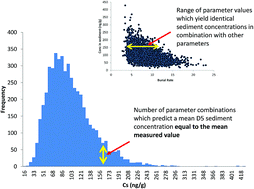Uncertainty and equifinality in environmental modelling of organic pollutants with specific focus on cyclic volatile methyl siloxanes†
Abstract
Multi-media fate and transport models (MFTMs) are invaluable tools in understanding and predicting the likely behaviour of organic pollutants in the environment. However, some parameters describing the properties of both the environmental system and the chemical pollutant under consideration are uncertain and or variable in space and time. Furthermore, model performance is often evaluated using sparse data sets on chemical concentrations in different media. This can result in equifinality – the phenomenon in which several different combinations of model parameters can result in similar predictions of environmental concentrations. We explore this idea for MFTMs for the first time using, as examples, three cyclic volatile methyl siloxanes (cVMS: D4, D5 and D6) and the QWASI lake model applied to Tokyo Bay. Monte Carlo simulation was employed with parameters selected from probability distributions representing estimated uncertainty in a large number of iterations. This generated distributions of predicted chemical concentrations in water (CW) and sediment (CS) which represent the aleatory uncertainty envelope but which also demonstrate significant equifinality. For all three compounds, the uncertainty implied in the CW was lower (coefficient of variation, CV, of the order of 20%) than for CS (CV ca. 45%), reflecting the propensity of cVMS compounds to sorb to sediment and the sensitivity of the model to KOC. Confidence intervals were particularly high for the persistence of D5 and D6 in sediment which both ranged between approximately 1.7 years and approximately 26 years for Tokyo Bay. Predicted concentration distributions matched observations well for D5 and D6 not for D4. Equifinality could be reduced by better constraining acceptable parameter sets using additional measured data from different environmental compartments.



 Please wait while we load your content...
Please wait while we load your content...